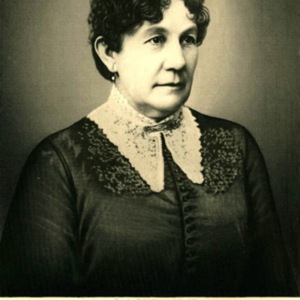Pioneer Women
- Home
- Early Settlement
- Exhibits
- Pioneer Women
By Anna Claspy, revised by Jordan Wilson
The first families to come to Wayne County in the early 1800s endured a hard life in what was then a secluded, wolf-ridden area on the edge of their known world. Pioneer mothers faced the hard task of creating a comfortable family home. When the nearest doctors and schools were miles away, much of the responsibility fell on the women. The isolation of the area and unpredictable experiences meant that the women needed to be resourceful in order to create a home in the wilderness. Throughout the first few decades of the nineteenth century, pioneer women helped Wooster grow from a group of log cabins in the woods to a busy and prosperous town.
Responsibility of Pioneer Mothers

The women of early nineteenth century Ohio were constantly on their feet, “washing, baking, scouring, cooking.”1 The workday was never far from their minds, even in those moments when they could relax and write letters to friends back home. These letters give us our greatest insight to the difficult lives of pioneer women. Anna Briggs Bently, a Quaker woman, wrote “I feel very tired now and look forward to tomorrow as a treat for I have a great pile of patching to do that I can sit down to.”2 However, work was not limited to cooking and cleaning. Pioneer women would also sew, weave, and sell products at the market, which created a home economy that was essential for their survival. On top of this, they also educated their children – often as many as ten to fifteen.3
For the first few years of Wooster’s existence, the lives of these women were full of uncertainty and they could not rely on their husbands to come home each night. This meant that women had to be strong, smart, and able to adapt quickly and constantly to a world where danger and disaster were everyday concerns. Women became protectors, learning how to use a rifle to defend themselves and their children, as well as farmers, tending to animals and crops, and manufacturers, creating products to sell at the market. Their sacrifices and hard work helped establish Wooster as a community.
To read more from Anna Briggs Bently, click here.
Mrs. McBride

Ann Julia McBride came to Wooster with her husband, Alexander, and their three small children in 1813 from Westmoreland, Pennsylvania.4 She was an intelligent woman and quick to act when her family was in danger, two qualities essential to the survival of her family. On one occasion, Mrs. McBride woke up in the dead of the night to discover a venomous snake had found its way under the floor of their house. Waking her husband, Ann ran to fetch a steel shovel. While Alexander pulled the floorboard up, Ann brought the shovel down and cut the snake’s head off.
Another time, when Mr. McBride was away, a rabid dog ran into the family’s house and began to gnaw on the bed where the McBrides’ one-year-old daughter, Margaret, was asleep. She got the family axe, opened the door and hit the dog over the head, killing it immediately.5




Nostalgia for the Pioneer Days
By the 1870s, many people expressed a nostalgia for pioneer days, perhaps because they heard stories passed down from their grandparents about a simpler time. In his 1878 history of Wayne County, Ben Douglass celebrated the contributions of the Pioneer mother: “And what shall be said of the Pioneer mothers? Heaven’s blessing be upon them! How comforting to believe that in that procession of beatified and redeemed souls which forever circle around and are closest to the Throne, the mothers are there!… There was no hardship they were not willing to endure, no sacrifice they were not ready to incur.”6 Pioneer women experienced extreme hardships, including loneliness, early death, and often the death of their children. They were more than cook and mothers – they helped build the economy of early Wooster and educate its youth. Pioneer women provided the foundation from which Wooster as we know it arose.

Consider the life of Adelaide Critchfield, which was cut short by a tragic fire in 1895. In addition to the staggering responsibilities of pioneer women, Adelaide took on new responsibilities as an organizer and activist in both the abolition and temperance movements. She was also a key member of the Methodist Church and practiced what she learned from reading the Bible habitually. Mrs. Critchfield died at the age of sixty-one while attempting to put out the fire that destroyed her home.7 Critchfield displayed much of the intelligence and bravery revered in pioneer women, especially in her actions to advance women’s roles in the city of Wooster.
To read a 1910 description of Adelaide Critchfield, click here.
Sources
1 Foster, Emily. The Ohio Frontier. Lexington, Kentucky: The University Press of Kentucky, 1996. 164.
2 Ibid.
3 Knepper, George W. Ohio and its People.Kent, OH: Kent State University Press, 1997. 124.
4 Ben Douglass. History of Wayne County, Ohio. Indianapolis, Ind: Robert Douglass, 1878. 744.
5 Ibid.
6 Ben Douglass. History of Wayne County, Ohio. Indianapolis, Ind: Robert Douglass, 1878. 184.
7 History of Wayne County, Ohio Vol. 1. Indianapolis Ind: B. F. Bowen & Co., 1910. 560.
How to cite this page:
MLA: “Pioneer Women.” stories.woosterhistory.org, http://stories.woosterhistory.org/pioneer-women/. Accessed [Today’s Date].
Chicago: “Pioneer Women.” stories.woosterhistory.org. http://stories.woosterhistory.org/pioneer-women/ (accessed [Today’s Date]).
APA: (Year, Month Date). Pioneer Women. stories.woosterhistory.org. http://stories.woosterhistory.org/pioneer-women/


